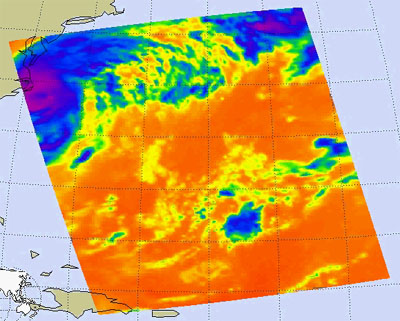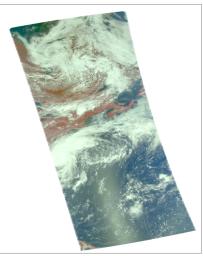
Click on the image for August 3, 2004 movie,
slicing down the atmosphere with the AIRS infrared sensor
These images of hurricane Alex were captured on August 3, 2004 at 1:30pm EDT. Located in the Atlantic Ocean located about 80 miles south-southeast of Charleston, South Carolina, Alex is now a category 2 hurricane with maximum sustained winds were near 100 mph (161 kph). Alex's center was about 65 miles (104 kilometers) northeast of Cape Hatteras and moving away from the U.S. coast.
The major contribution to radiation (infrared light) that AIRS infrared channels sense comes from different levels in the atmosphere, depending upon the channel wavelength. To create the movies, a set of AIRS infrared channels were selected which probe the atmosphere at progressively deeper levels. If there were no clouds, the color in each frame would be nearly uniform until the Earth's surface is encountered. The tropospheric air temperature warms at a rate of 6 K (about 11 F) for each kilometer of descent toward the surface. Thus the colors would gradually change from cold to warm as the movie progresses.
Clouds block the infrared radiation. Thus wherever there are clouds we can penetrate no deeper in infrared. The color remains fixed as the movie progresses, for that area of the image is "stuck" to the cloud top temperature. The coldest temperatures around 220 K (about -65 F) come from altitudes of about 10 miles.
We therefore see in a 'surface channel' at the end of the movie, signals from clouds as cold as 220 K and from Earth's surface at 310 K (about 100 F). The very coldest clouds are seen in deep convection thunderstorms over land.
Images
August 2, 2004, 1:30am ET
Frame from August 2 movie, slicing down the atmosphere with the AIRS infrared sensor. Alex a tropical storm, sustained winds at 60 mph. The storm is 115 miles southeast of Charleston, South Carolina, traveling northeast at 6 mph.
August 1, 2004, 1:30am ET
Daylight snapshot from AIRS visible/near-infrared. At the time AIRS made this observation, Alex was still a tropical depression and just getting organized.
Movies
Slice down the atmosphere with the AIRS infrared sensor.
August 3, 2004, 1:30am ET
Alex becomes the first hurricane of the 2004 North Atlantic season with sustained winds at 75 mph.

August 2, 2004, 1:30pm ET
Alex is located about 120 miles southeast of Charleston, South Carolina. Alex has now begun to move to the northeast and a general northeastward track is expected the next couple of days with a gradual acceleration in forward speed as it begins to interact with stronger upper level winds.

August 2, 2004, 1:30am ET
Alex now has sustained winds of 35 knots.

August 1, 2004, 1:30pm ET
Alex is tropical depression and beginning to get organized.
About AIRS
The Atmospheric Infrared Sounder, AIRS, in conjunction with the Advanced Microwave Sounding Unit, AMSU, senses emitted infrared and microwave radiation from Earth to provide a three-dimensional look at Earth's weather and climate. Working in tandem, the two instruments make simultaneous observations all the way down to Earth's surface, even in the presence of heavy clouds. With more than 2,000 channels sensing different regions of the atmosphere, the system creates a global, three-dimensional map of atmospheric temperature and humidity, cloud amounts and heights, greenhouse gas concentrations, and many other atmospheric phenomena. Launched into Earth orbit in 2002, the AIRS and AMSU instruments fly onboard NASA's Aqua spacecraft and are managed by NASA's Jet Propulsion Laboratory in Pasadena, Calif., under contract to NASA. JPL is a division of the California Institute of Technology in Pasadena.
More information about AIRS can be found at http://airs.jpl.nasa.gov.

 Planetary Data System
Planetary Data System



















